Physical Address
304 North Cardinal St.
Dorchester Center, MA 02124
![]() For videos accompanying this chapter and supplementary materials see ExpertConsult.com. See inside cover for access details.
For videos accompanying this chapter and supplementary materials see ExpertConsult.com. See inside cover for access details.
Nystagmus consists of rhythmic ocular oscillations. Pathological nystagmus is involuntary, although it may be modulated when performing certain tasks such as reading. Infantile nystagmus is defined as nystagmus developing in the first 3–6 months of life. Nystagmus can be acquired later in life, usually due to neurological diseases. Patients with acquired nystagmus have oscillopsia, the illusion that the environment is moving. Patients with infantile nystagmus, however, usually have a stable view of the environment, probably due to neuronal plasticity and adaptation during visual development.
Nystagmus in childhood can be idiopathic or associated with retinal diseases, low vision in infancy, and a variety of syndromes and neurological diseases. Nystagmus associated with neurological disorders in childhood may be similar in appearance and pathophysiology to acquired nystagmus. Onset may also be after 6 months of age. The estimated prevalence of nystagmus (including both infantile and acquired nystagmus) is 24 in 10,000. The prevalence of infantile nystagmus is 14 per 10,000. Idiopathic nystagmus and nystagmus associated with ocular disease are the most common forms of nystagmus in childhood. The clinical diagnoses associated with infantile nystagmus are shown in Fig. 90.1 .
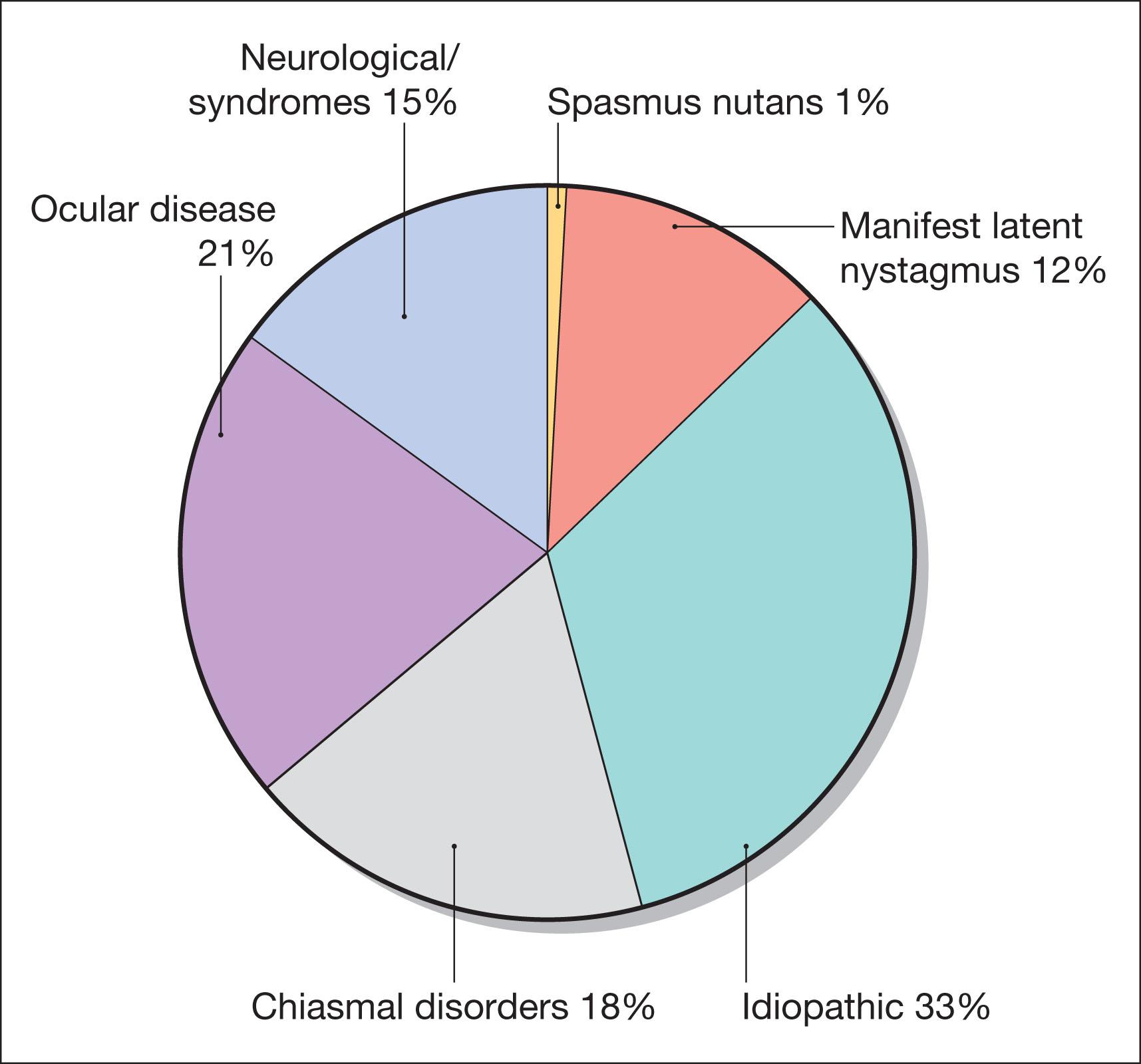
The causes of most forms of infantile nystagmus are as yet unknown, although this is currently an active field of research. In general, infantile nystagmus is considered to be a disorder of gaze-holding and slow eye movement systems, leading to sinusoidal oscillations and/or drifts of the eye away from the intended point of fixation. These involuntary slow eye movements constitute nystagmus slow phases. The slow phases are interrupted and shaped by the interposition of nystagmus quick phases, which serve to re-align the eyes.
Many types of infantile nystagmus are associated with the presence of sensory abnormalities during early visual development. With afferent diseases such as achromatopsia and congenital cataract, the nystagmus is clearly the result of changes in the otherwise healthy ocular motor systems in response to afferent deficits present during visual development. For other conditions such as albinism and various syndromes, it is uncertain whether the nystagmus is also due to afferent deficits or directly caused by abnormalities in ocular motor neural circuitry.
Investigations into the quality of life of adults and children with infantile nystagmus show that the effects on visual function are considerable and are comparable to the effects of diseases such as age-related macular degeneration. Semiquantitative interviews of people with infantile nystagmus revealed universally negative experiences of living with nystagmus and allowed the development of a 29-item, nystagmus-specific QOL questionnaire. Infantile nystagmus has a much wider impact than simply reducing vision. It affects social interaction, due to lack of confidence caused by the cosmetic appearance of nystagmus, and restriction in mobility of many patients, as they are not able to drive. Consequently, treatment of nystagmus should not only aim at improving visual acuity but also at improving cosmesis. This might include, for example, the correction of abnormal head postures and the reduction of nystagmus intensity in patients with poor visual potential. Patients may also benefit from counseling services and support groups such as Nystagmus Network, UK ( http://www.nystagmusnet.org ) or the American Nystagmus Network ( http://www.nystagmus.org ).
There has been significant controversy over the classification and terminology used in nystagmus. This is because some researchers have been mainly interested in the morphology of nystagmus waveforms and others in clinical etiology.
The advantages of using a clinical classification of infantile nystagmus based on the associated diseases are that the clinical implications such as prognosis, possible genetic counseling, or treatment options are immediately highlighted. Figure 90.2 lists examples of disorders using this type of classification. Idiopathic nystagmus has historically been a diagnosis of exclusion where all other eye examinations are negative. The visual acuity is 0.3 LogMAR or better in most patients, suggesting relatively good retinal function. However, retinal abnormalities have been recently identified in idiopathic nystagmus using optical coherence tomography (OCT). Mutations in the FRMD7 gene have been identified as a major cause of X-linked idiopathic nystagmus. Several genetic mutations are known for other disorders such as albinism and achromatopsia. It is likely that the nystagmus genotype will be the principal method of classification in the future.
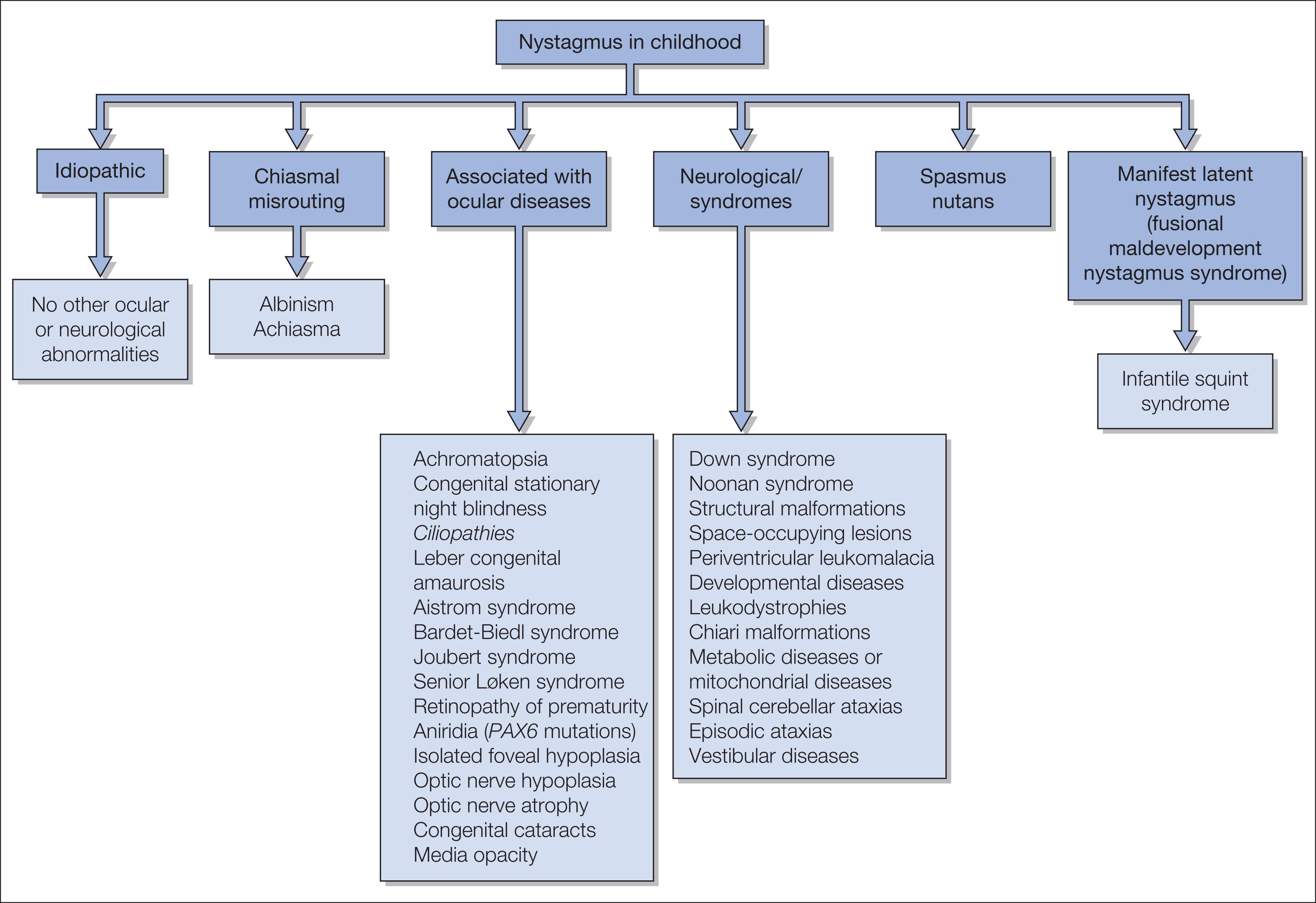
The Committee for the Classification of Eye Movement Abnormalities and Strabismus Workshop (CEMAS; http://nei.nih.gov/sites/default/files/nei-pdfs/cemas.pdf ) have grouped together idiopathic nystagmus, nystagmus associated with ocular diseases, and nystagmus associated with chiasmal misrouting into one category called “infantile nystagmus syndrome.” In a clinical setting, this classification is less helpful and makes unconfirmed assumptions about a common mechanism leading to nystagmus in all of the underlying pathologies.
Nystagmus can be characterized by clinical examination of the patient. Eye movement recordings can help by providing greater precision in detecting and describing nystagmus waveforms, which can assist in the diagnosis ( Figs. 90.3 and 90.4 ). The following parameters can be used to describe nystagmus:
Plane: The plane of oscillation can be horizontal, vertical, torsional, or a combination of more than one plane (e.g. Fig. 90.3C2 ).
Intensity: The intensity of the nystagmus is a measure of the speed of the eye movements and is obtained by multiplying the nystagmus amplitude (in degrees, °) and frequency (oscillations per second in Hertz, Hz).
Waveform: Nystagmus can be broadly classified into jerk and pendular waveforms. Jerk nystagmus consists of alternating slow and quick phase eye movements. The nystagmus direction is defined using the quick phase. Slow phases can have an increasing velocity profile where the eyes start slowly and accumulate speed (e.g. Fig. 90.4A in right gaze). Alternatively, slow phases may have decreasing velocity (e.g. Fig. 90.4C ) or linear velocity profiles. In contrast, pendular nystagmus consists of approximately sinusoidal oscillations without quick phases (e.g. Fig. 90.4A at null region). Dual jerk nystagmus is a combination of large jerk nystagmus waveforms with small pendular nystagmus waveforms superimposed along the same plane.
Conjugacy: If both eyes move together, i.e. with the same amplitude, frequency and plane, the nystagmus is conjugate. Dysconjugacy or dissociated nystagmus occurs if the eyes move with different amplitude (e.g. torsional eye movements in Fig. 90.3A3 ), frequency, phase (e.g. vertical eye movements in Fig. 90.3C2 ) or along different planes.
Foveation: Most types of infantile nystagmus show periods in the nystagmus cycle when the eyes move at a slower velocity. These slow periods are often used to align the fovea with visual targets to improve visual acuity, and hence are called foveation periods.
Null region: Many patients with infantile nystagmus prefer a particular gaze direction where the nystagmus is reduced in intensity and visual acuity is optimal. This is called the null region. If the null region is not in the primary position, patients may adopt an abnormal head posture (AHP) using the null region to improve vision when looking straight ahead. An example is shown in Fig. 90.4A2 where the null region is in right gaze.
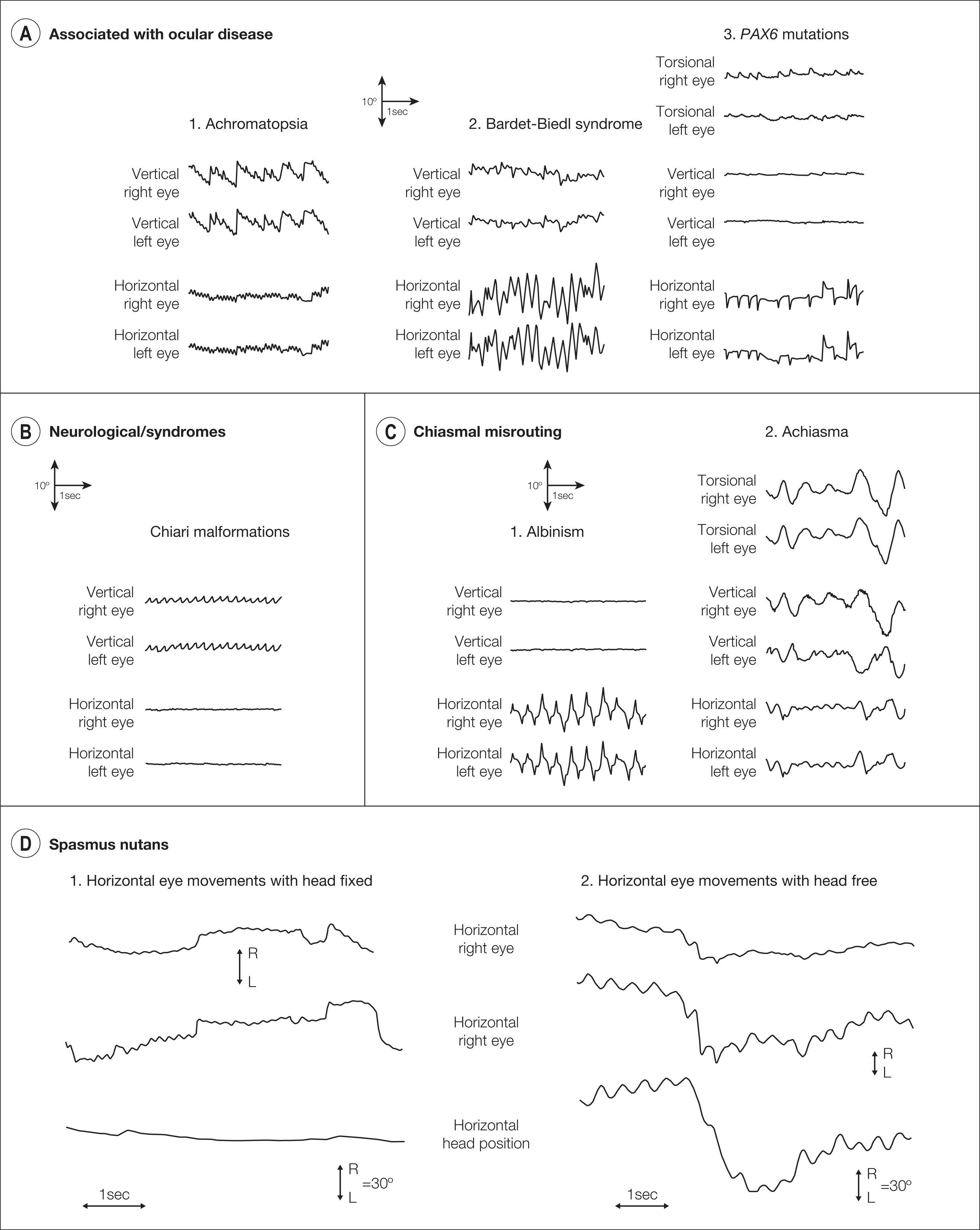
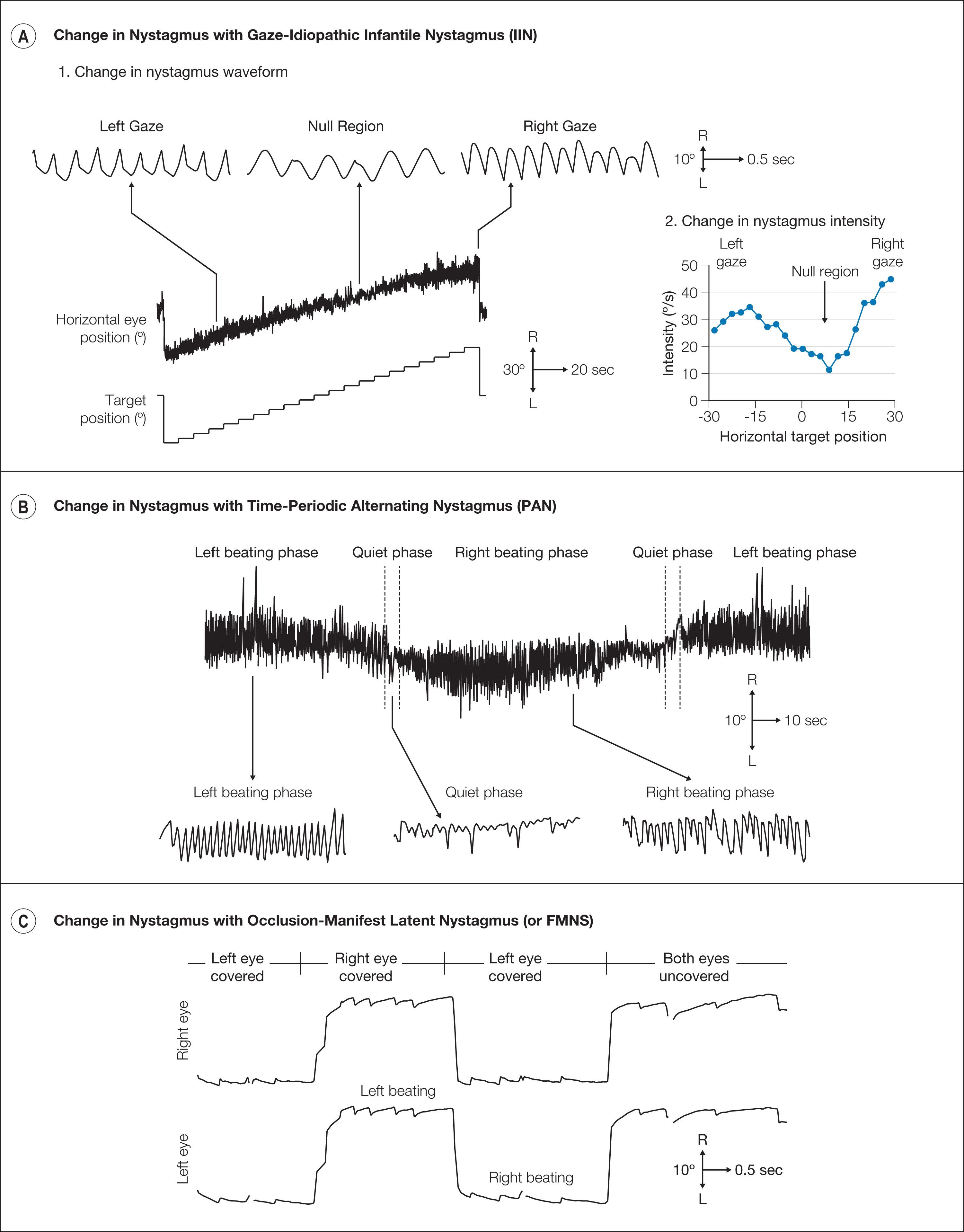
Infantile nystagmus is not always uniform but can change depending on several factors:
Change with gaze: Patients with nystagmus associated with albinism and idiopathic nystagmus usually have a null region. The nystagmus becomes more jerk-like (see Fig. 90.4A1 ) and intense (see Fig. 90.4A2 ) away from the null region.
Change with time: Most patients have a consistent oscillation when attempting to maintain a fixed gaze position. However, certain types of nystagmus vary with time. In periodic alternating nystagmus (PAN) the fast phase beats periodically to the right and to the left with quiet periods at the changeover periods (see Fig. 90.4B ).
Change upon covering one eye: In manifest latent nystagmus (MLN), the fast phase of nystagmus changes direction beating towards the open or fixing eye (see Fig. 90.4C ).
It is important to establish the time of onset for the nystagmus since infantile nystagmus occurs usually in the first 3, or sometimes 6, months of life.
As several forms of infantile nystagmus are hereditary, establishing whether other family members have nystagmus or associated ocular diseases can help with the diagnosis. If there is a positive family history, determining the mode of inheritance is very important. Idiopathic nystagmus often occurs in an X-linked pattern in which heterozygous females are fully affected in approximately 50% of cases (i.e. 50% penetrance). In contrast, only males are fully affected in X-linked congenital stationary night blindness (CSNB), blue cone monochromatism, or ocular albinism. Oculocutaneous albinism and achromatopsia are usually autosomal recessive. Recently, a new recessively inherited syndrome consisting of foveal hypoplasia, optic nerve decussation defects, and anterior segment dysgenesis without oculocutaneous hypopigmentation (FHONDA syndrome) has been described. The most common form of autosomal dominant nystagmus is caused by mutation in PAX6 genes.
Where neurological deficits such as cerebral palsy, metabolic diseases, or other causes of developmental delay are present, they are likely to play a key role in the etiology of the nystagmus.
It is important to establish whether parents think their child has poor vision. Although nystagmus can be of very large amplitude at onset and parents can have the impression that the child is visually unresponsive, usually the nystagmus amplitude is considerably smaller by 6–9 months of age. Explaining to parents that nystagmus generally changes and becomes less evident as their child becomes older is important, and therefore caution should be taken about predicting poor vision later in life. Optical coherence tomography (OCT)-based grading of the structure of the fovea is a good predictor of later visual acuity in infantile nystagmus.
Often children with nystagmus have head nodding or bobbing. This seems to be an independent abnormal head movement, which can decrease or disappear with age. Only in spasmus nutans has head nodding been shown to reduce or abolish nystagmus (see Fig. 90.3D ).
A history of photophobia should be specifically asked for. This would be indicative of a retinal disease, particularly achromatopsia or blue cone monochromatism. Similarly, a history of night blindness should be specifically asked for. This suggests a rod–cone dystrophy and is common in congenital stationary night blindness.
Symptoms of oscillopsia are a feature of acquired nystagmus and seldom occur in children. Some patients with infantile nystagmus, however, perceive oscillopsia if they look away from the null region or if the nystagmus changes, for example in manifest latent nystagmus (MLN), which can change with the degree of strabismus. The oscillopsia in acquired nystagmus is usually sudden in onset and severe. In contrast, the time of onset of oscillopsia in infantile nystagmus is generally not as well defined and the symptoms are milder.
Visual acuity (VA) needs to be examined with the best optical correction and tested with both eyes open and either eye covered with a free head position. This is important, as manifest latent nystagmus, alone or superimposed on other infantile nystagmus waveforms, can increase the nystagmus and decrease VA when one eye is covered. VA should also be measured at distance and near. In infants, VA tests can be performed using preferential looking cards. In patients with horizontal nystagmus, measurement of VA can be assisted by vertically aligning the cards, making it easier to identify changes in fixation when the child looks up or down at the visual targets on the card. This can be masked by the horizontal nystagmus if the card is aligned horizontally. The presence of vertical optokinetic nystagmus can also be used to predict the likelihood of better VA in horizontal nystagmus. It has been shown that grading of the structure of the fovea on OCT is a good predictor of later visual acuity in infantile nystagmus.
Abnormal head posture (AHP) (or torticollis) occurs commonly in nystagmus because many patients can reduce their nystagmus by looking in a certain direction of gaze, for example by directing gaze towards the null region. In most patients, the full extent of torticollis is only observed during visual effort. So to identify the full amount of AHP, ask the patient to read or look at pictures ( Fig. 90.5A ). Glasses can prevent the patient adopting the full head turn due to the spectacle frame and optical decentration. VA measurements should be repeated, therefore, without spectacles. Figure 90.5B shows a child with idiopathic infantile nystagmus (IIN) and a right head turn increasing as he reads smaller letters. With a greater visual demand, a large head turn is adopted and he looks over his glasses or prefers to read without glasses since the full head turn is prevented by the glasses.
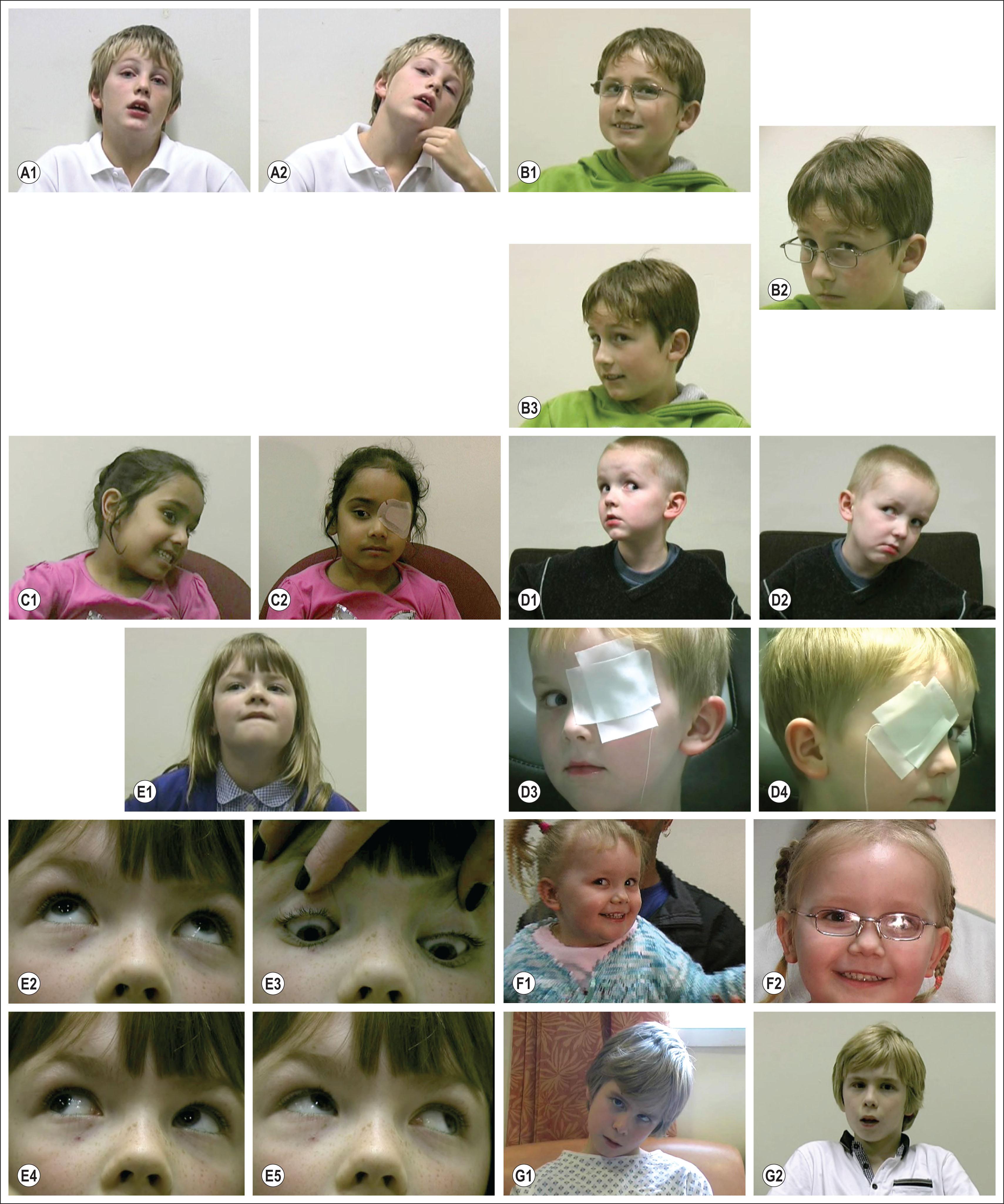
Manifest latent nystagmus dampens on adduction. As a result, the patient adopts a head turn to keep the fixing eye adducted ( Fig. 90.5C ). In manifest latent nystagmus, the head position also needs to be examined with each eye covered, as the head position can change depending on the fixing eye ( Fig. 90.5D ). Patients with A or V pattern strabismus may adopt a chin-up or chin-down head position in order to maintain binocular function and thus reduce the amplitude of the nystagmus ( Fig. 90.5E ). Eye movement recordings are helpful in understanding abnormal head postures, for example in establishing whether the head posture is due to idiopathic nystagmus (see Fig. 90.4A ) or manifest latent waveforms (see Fig. 90.4C ). They can also be used to determine whether the adopted head posture leads to a reduction or change in the nystagmus.
Orthoptic examination should include an assessment of strabismus at distance and near, the range of motility of each eye, binocularity, stereopsis, and fusion ranges if binocular vision is present.
This is important to detect achromatopsia and other retinal or optic nerve diseases.
Photophobia is easily noted on slit-lamp or fundus examination and points to achromatopsia or other retinal dystrophies. Nyctalopia can be objectively measured using dark adaptometry and may indicate congenital stationary night blindness or other retinal dystrophies.
Become a Clinical Tree membership for Full access and enjoy Unlimited articles
If you are a member. Log in here